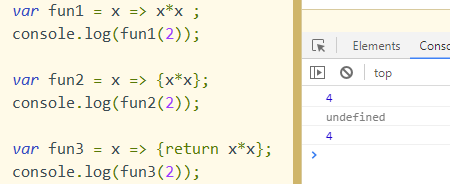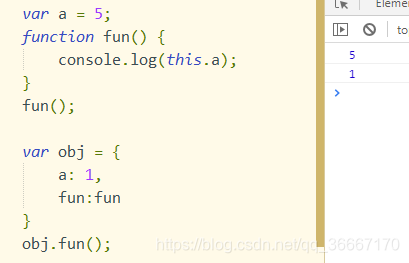普通的this
- 如果单独使用,this 表示全局对象。
- 在函数中,this 表示全局对象。
- 在函数中,在严格模式下,this 是未定义的(undefined)。

- 在方法中,this 表示该方法所属的对象。
- 在事件中,this 表示接收事件的元素。

- 类似 call() 、apply()、bind() 方法可以将 this 引用到任何对象。
var name = "我是window";
// 单独使用
console.log(this.name); //我是window
// 在函数中
function myFunction() {
name: "我是myFunction",
console.log(this.name); //我是window
}
myFunction();
//对象中有自己声明的量
var myObj1 = {
name: "我是obj1",
myfun1: function() {
console.log(this.name); //我是我是obj1
}
};
myObj1.myfun1();
//对象的this
var myObj2 = {
name: this.name,
myfun2: function() {
console.log(this.name); //我是window
}
}
myObj2.myfun2();
//使用call apply bind
myObj2.myfun2.apply(myObj1); //我是我是obj1
myObj2.myfun2.call(myObj1); //我是我是obj1
myObj2.myfun2.bind(myObj1)(); //我是我是obj1
箭头函数
函数名 = () => {函数体}
- 没有参数或者参数不止一个时一定要写
(),只有一个参数可以不写

- 函数体只有一条语句,可以不用
{},默认返回结果;函数体有多个语句, 需要用{},若需要返回值,则自己手动写return。

使用场景:多用来定义回调函数
划重点:箭头函数没有自己的this,箭头函数的this不是调用的时候决定的,而是在定义的时候处在的对象就是它的this
普通函数,被谁调用this就指向谁。

箭头函数的this看外层的是否有函数,
- 如果有,外层函数的this就是内部箭头函数的this,
- 如果没有,则this是window。
下边列举三个例子:
图1中
- 直接定义了箭头函数fun函数,fun的this指向window,
- 将fun作为对象obj的方法,fun的this依旧指向window,
- 在fun中定义一个兼有函数get,get外部没有函数,所以依旧指向window

在图2中
- 在外部定义了箭头函数fun,fun的指针指向window
- 在函数demo中将fun作为方法调用,由于fun是定义在外部的,因此fun依旧指向window
- 在函数demo内部定义箭头函数get,get的外层函数是fun,因此get的指针就与demo相同,demo被对象obj调用,demo的指针指向obj,因此fun的指针也指向obj。

图3中
- 普通函数demo1和箭头函数demo2均为obj的方法
- 箭头函数get1的外层函数是普通函数demo1,demo1的this指针由调用它的对象决定,因此demo1指向obj,而get1的this指针与外层函数相同,所以get1的this指针也指向obj
- 箭头函数get2的外层函数是箭头函数demo2,demo2的this指针由它的外层函数决定,但是demo2没有外层函数,因此指向window,而get2的this指针与外层函数相同,所以get2的this指向window

